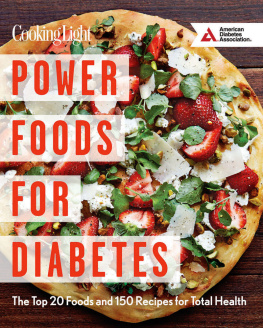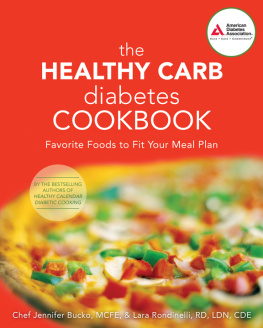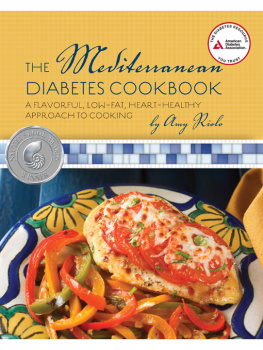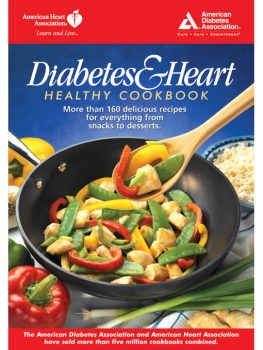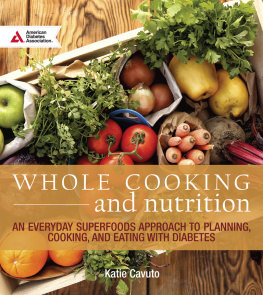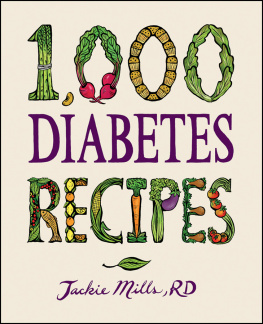POWER
FOODS
FOR
DIABETES

Contents

What Can I Eat Now?
Once youve been diagnosed with type 1 or type 2 diabetes, knowing what foods are good for you and how to incorporate them into your lifestyle is essential. In this chapter, Cooking Light and the American Diabetes Association give you meal planning and lifestyle advice, practical answers to everyday questions, and an easy-to-understand glossary of the top Power Foods.
WHEN YOU EAT A MEAL, the levels of glucose in your blood naturally rise because of the sugars and starches in the food. In response to the elevated glucose, the pancreas secretes insulin, a hormone that tells the bodys cells to absorb the extra glucose. In type 1 diabetes, an autoimmune disease that occurs most frequently in young people but can be diagnosed at any age, the cells that produce insulin are destroyed and the body stops or greatly reduces the amount of insulin produced. With type 1 diabetes, you must inject or pump insulin daily.
In type 2 diabetes, the body does not produce enough insulin, is unable to use insulin to adequately lower blood glucose, or both. Ninety to 95 percent of people with diabetes have type 2 diabetes. A healthy diet and physical activity are major components of successfully treating and managing type 2 diabetes. In addition, people with type 2 diabetes may take medications, including insulin, to lower blood glucose levels.
An eating plan that includes lean protein, fruits and vegetables, beans, healthy fats, and fat-free dairy foodsall of which are Power Foodscan help control blood glucose levels and help prevent or control other complications of diabetes, such as heart disease and eye, kidney, and nerve damage.
To get started with making healthful changes, work toward incorporating the following eight essentials for good health into your daily life. But remember to be patient with yourself. It takes time for changes to your lifestyle to become habits, so focus on achieving one objective at a time.
Healthy Living Basics
INCORPORATE POWER FOODS INTO MEALS.
Power Foods are nutrient dense, meaning they are an excellent source of nutrients such as protein, heart-healthy fats, vitamins, minerals, and antioxidants. Power Foods are natural foods that have not undergone excessive processing that removes fiber or other nutrients. Once you know what the are, they can form the foundation of meals you prepare at home as well as those you enjoy with family and friends away from home. As with all foods, enjoy Power Foods in serving sizes that fit into your personal eating plan. With each Power Food, youll find a list of recipes in the book that use the ingredient in a variety of great-tasting dishes.
CHOOSE SMART CARBS.
Whole grains, beans, and sweet potatoes are all high-carb foods, but they are smart carbs because they contain fiber, vitamins, minerals, and phytochemicals that are beneficial to your health. Smart carbs are nourishing, high-carbohydrate foods that are whole foods or minimally processed.
As an example, 1/3 cup of brown rice has about the same amount of carbs and calories as 1/3 cup of white rice. But brown rice is a smart carb because it has more fiber and is rich in B vitamins and trace minerals contained in the outer hull, bran, and germ, which are removed when white rice is produced.
Other smart carbs include fresh fruits; whole grains such as oats, quinoa, and wild rice; and 100% whole-grain breads and pastas. Serving size is still important, even for smart carbs: 1/3 to 1/2 cup is a typical serving size, depending on the food.
MINIMIZE ADDED SUGARS.
Sugary foods, such as cakes, cookies, pies, and brownies, should be occasional treats when you have diabetes since they cause blood sugars to spike. In addition to sugar, desserts usually contain butter or oil as well as other carbohydrates from white flour, making them high-calorie, low-nutrient additions to your meal.
You should, of course, sometimes treat yourself to a slice of birthday cake or a piece of pie, but youll need to substitute the dessert for other carbohydrates in your meal. For example, if you are going to enjoy a slice of cake that has 30 grams of carbs, youll need to eliminate a slice of bread from lunch (make your sandwich open-faced) to cut 15 grams of carbs and skip the potatoes at dinner to cut an additional 15 grams of carbs.
If sugars were only in desserts, it would be easy to track them, but they are also in many processed foods. Check labels on tomato sauce and pasta sauce, baked beans, frozen dinners, flavored instant oatmeal, flavored yogurt, and non-dairy milk (like soy milk). Sugar lurks in ingredients with names other than sugar. Look for honey, maple syrup, agave, molasses, high fructose corn syrup (sometimes called corn sugar), and turbinado (raw) sugar in the ingredient list on labels.
Avoid sugar-sweetened beverages. They have been linked to developing type 2 diabetes and worsening cardiovascular risk factors. Plus, they offer no nutritional value other than extra calories. Instead of drinking sugar-sweetened soft drinks, energy drinks, tea, and sports beverages, opt for artificially sweetened or unsweetened beverages or water.
BOOST FIBER.
Fiber is the indigestible part of fruits, vegetables, beans, and grains. All dietary fibers are either soluble or insoluble, and both are important for digestion, health, and preventing conditions such as heart disease, diabetes, and obesity. The difference is that soluble fiber dissolves in water, while insoluble does not. This affects how each benefits your health. Soluble fiber, found in beans, lentils, oats, apples, oranges, cucumbers, and carrots, attracts water, which slows digestion. Slow stomach emptying helps you feel full longer and may also have a beneficial effect on blood sugar levels. Insoluble fiber, found in whole grains, seeds, nuts, and vegetables, doesnt dissolve in water, so it passes through the intestinal tract almost intact. This added bulk is beneficial for intestinal health.
High-fiber meals usually require a lot of chewing, which slows you down and makes you more attuned to when youve had enough to eat. Fiber adds no calories to your diet, yet it bulks up meals, making you feel full for a longer time.
The American Diabetes Association recommends a minimum of 25 grams of fiber a day for women and 38 grams for men. Most Americans consume only about half this amount. To incorporate more fiber into your everyday meals, choose a high-fiber breakfast cereal with no added sugars; add beans or lentils to soups and top your salads with seeds, nuts, and a variety of vegetables; choose 100% whole-grain breads and pastas; and enjoy whole fruits for snacks and desserts.
CHOOSE HEALTHY FATS.
All fats are high in caloriesthere are about 120 calories in a tablespoon of any type of oilso youll want to keep portions small even for healthy fats. Fat is a vital component of your diet. You need fat for energy; absorption of vitamins A, D, E, and K; and for healthy hair and skin.
But for heart health, its important to make smart choices about the fats you do include in your meals. The key is to substitute mono- and polyunsaturated fats for trans and saturated fats. (Your diabetes educator or registered dietitian will help you learn to substitute healthy for unhealthy fats.) Saturated fats and trans fats raise your cholesterol levels and having high cholesterol is a key risk factor for heart disease. Limiting these fats is particularly important for people with diabetes, since having diabetes already puts you at high risk for heart disease.
Next page
